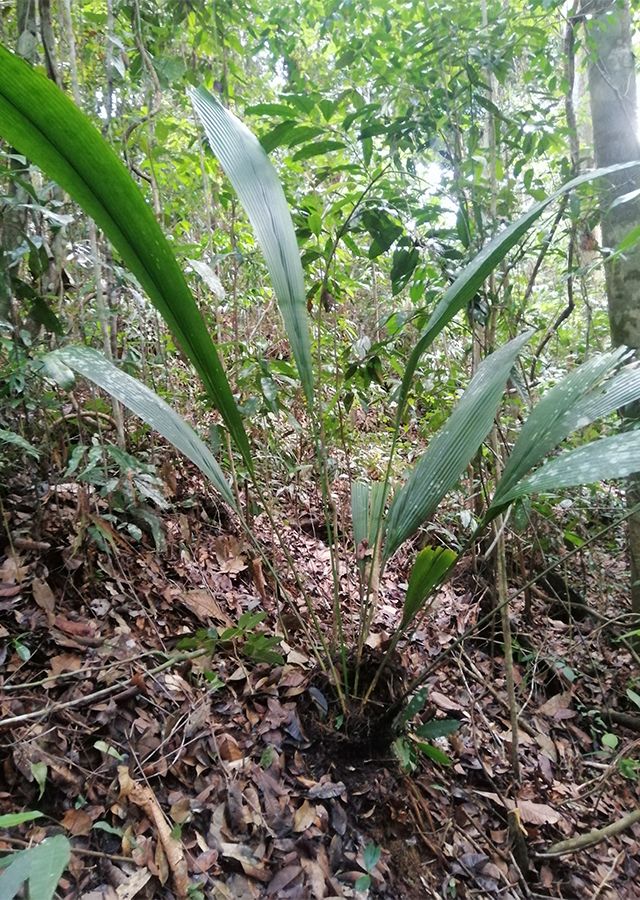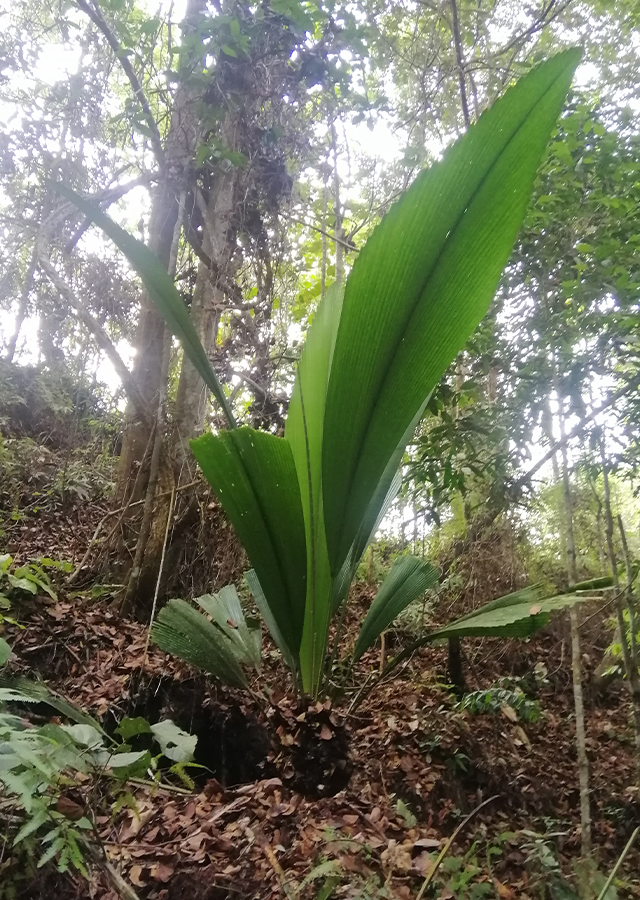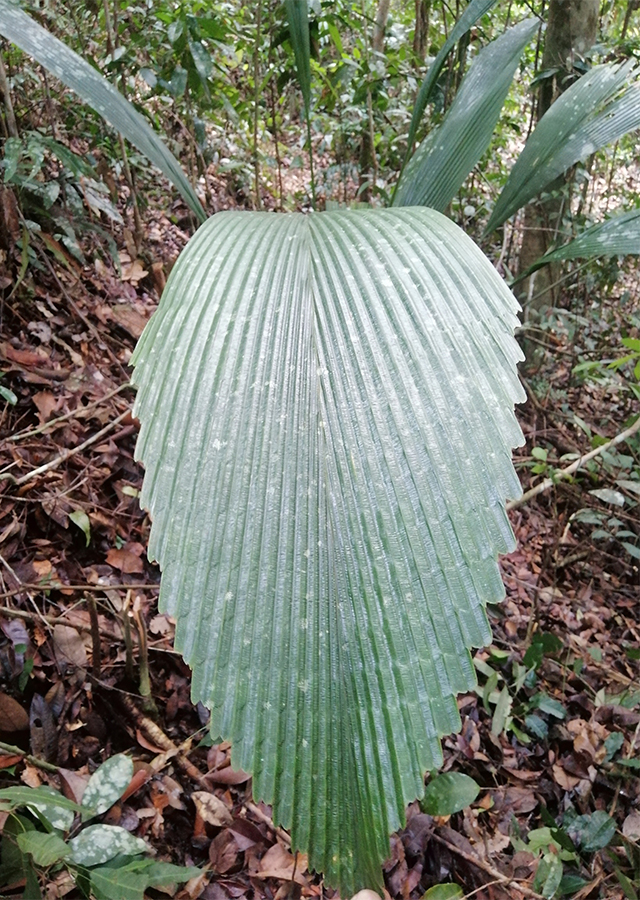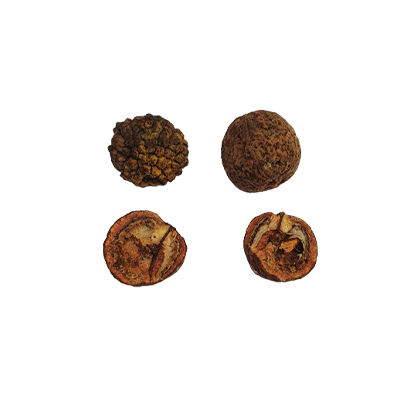Joey Palm
Johannesteijsmannia altifrons (Rchb.f. & Zoll.) H.E.Moore
Arecaceae
Location in our garden
Shading Area



Synonym
Teysmannia altifrons Rchb.f. & Zoll.
Habitus
Palm. Palms, annual, about 3-6 m high
Part Used
Leaves
Seeds
Twigs
Growing Requirements
Need Shade
Habitat
Forest
Terrestrial
Overview
Johannesteijsmannia altifrons is a palm plant that is commonly found in Southeast Asia, including Malaysia (Taman Negara National Park, East Johor, and Bake National Park in West Sarawak), Indonesia (Sumatra, Kalimantan), Thailand. In Indonesia this species is endemic to the Sumatra region, which is found and grows in the province of Riau and North Sumatra, but is also found growing in the province of Jambi. Joey palm or Johannesteijsmannia altifrons is a protected plant species based on PP No. 7 of 1999 and is a species whose potential is not widely known. Its utilization has so far been used by residents around the forest area as wall and roof material for huts in the fields. Due to its unique shape and size, Johannesteijsmannia altifrons can also be grown as an ornamental plant.
Vernacular Names
No found data on this. Need further research.
Agroecology
Johannesteijsmannia altifrons is generally found scattered or as pure stands in terrestrial, undergrowth in moist rain forest (primary and secondary) on ridge crests and hillsides on well-drained soil, mostly above 300-500 m asl. This species is never found in regrowth secondary forest and rarely survives tree felling, but often suffers considerable damage from fallen trees, and scorches when exposed to direct sunlight. Johannesteijsmannia altifrons does best in a warm, protected area, likes partial shade, can be grown indoors. This species requires well-drained soil, high humidity, and avoids over-watering. Does not tolerate drought and full sun, especially in dry climates. Johannesteijsmannia altifrons grows well in tropical and subtropical climates, but tolerates temperatures as low as -4 °C (USDA Zones 9b through 11) and is moderately cold tolerant, especially when grown in the shade. For safe cultivation, normal temperatures should not exceed below 5 °C. The root system is very sensitive to cold and must be protected if the temperature drops below freezing.
Morphology
- Stems - creeping underground.
- Leaves - large (up to 6 m long), broad, undivided, relatively hardy, usually single growing consisting of 20-30 leaves, erect, diamond-shaped, emerging directly from the ground, green in color, leaf margins serrated, firm texture, shiny surface, tapered at the tip and base of the leaf and wide in the middle of the leaf. Slightly lobed on the 2 upper edges and with prominent veins parallel to the lower 2 edges. The leaf midrib has a characteristic in the form of upturned spines on both sides. The petiole is armed with short spines.
- Flowers - hermaphrodite, has a fleshy crown, creamy white, up to 4 cm long. Inflorescences are small, panicle-shaped, located in the axils of the leaves, erect. The base is sheath-shaped. The bracts are 5-6, lanceolate.
- Fruits - woody, round with a rough surface, usually contains 1 seed, (rarely 2 or 3 seeds). The fruit is covered with 60 – 80 brown cork protrusions which are almost 1 cm high.
Cultivation
Propagation by seeds - germination is in about 3 months. Before sowing, soak the seeds for 1 day in warm water, then sow in a light mixture at 35 °C during the day, 25 °C at night.
Chemical Constituents
2-[(1′E)-3′-hydroxyl-1′-methyl-1′-propen-1′-yl]-6-methoxy-7-[(2′′-methylheptyl)oxy]-5-benzofurancarboxylic acid, β-sitosterol, γ-taraxasterol, and stigmasterol.
Traditional Medicinal Uses
- Overcome respiratory disorders, wounds.
- Reduce fever in children.
- The seeds are also grated into a powder and applied to the face, chest or tongue to cure sore throats, coughs and asthma.
Part Used
Reference Sources
- Royal Botanic Gardens. Plants of the World Online: Johannesteijsmannia altifrons (Rchb.f. & Zoll.) H.E.Moore. https://powo.science.kew.org/taxon/urn:lsid:ipni.org:names:667632-1. 24-06-22.
- Flora Fauna Web. 2021. Johannesteijsmannia altifrons. https://www.nparks.gov.sg/florafaunaweb/flora/5/0/5084. 24-06-22.
- LLIFLE - Encyclopedia of living forms. 2022. Johannestijsmania altifron. http://www.llifle.com/Encyclopedia/PALMS_AND_CYCADS/Family/Arecaceae/32980/Johannesteijsmannia_altifrons. 24-06-22.
- NOOR AZIIRAA SABRI, W.A. YAACOB, NUR SHAFIQA ABDULLAH. 2017. New Chemical Constituent from the Rhizomes of Johannesteijsmannia altifrons. Sains Malaysiana 46(8)(2017): 1285–1288. http://dx.doi.org/10.17576/jsm-2017-4608-14



